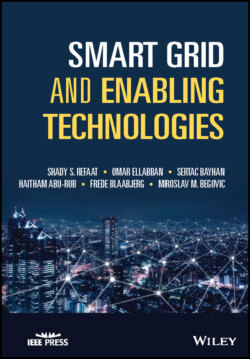Читать книгу Smart Grid and Enabling Technologies - Frede Blaabjerg - Страница 50
1.9.3 Digitalization and Technologies
ОглавлениеAdvancements in digitalization enhance the grid's utilization and management. Technologies that are digitalized have been increasingly used to allow devices across the grid to exchange beneficial data for the customers and grid operators. There is a huge interest in utilizing innovative Internet of Things (IoT) sensors, smart meters, network remote automation, distributed and centralized control systems, digital platforms, to spot the light on the grid's proper optimization and aggregation, enable real‐time operation of the network, and enhance grid's situational awareness and utility services [67]. The rise in the deployment of AMI shows clear opportunities for enhancing the quality of service, the observability of the network, and data gathering for short‐ and long‐term utilization. The grid's various digital data provides opportunities for fault detection, energy consumption and generation, as well as prediction of faults and outages. Digitalization of the network is an obvious opportunity for cost‐effective development and management of the electricity system with high returns in cost and quality to serve. On the consumer side, chances for the use of smarter customer technologies are being increased. The installation of digital technologies in the network should not be slowed down by outdated regulations. As more digital devices are deployed, the communication between these devices will be increased. Broadband communication infrastructure will support a wide range of services (both network and consumer services). Not having updated policies and standards can slow down the development of this infrastructure and hinder innovation in this space. There are more challenges for digitalization including available infrastructure and replacement cycles [68]. Technologies related to the SG have evolved from previous attempts at utilizing electronic control, metering, and monitoring. Back in the 1980s, automatic meter reading was implemented to keep track of loads from heavy consumers and emerged into the AMI of the 1990s [69]. These meters can record and store how electricity is utilized at various times of the day. Smart meters give continuous information so that monitoring can be achieved in real‐time and could be utilized as a gateway for “smart sockets” in the premises and for DR‐aware equipment [70]. The main technologies in the SG consist of three main parts: electric energy technologies, operation technologies, and information and communication technologies as described in Figure 1.19. Energy technologies include renewables energy, distribution generation, DR, EVs, ES, integrated gasification combined cycle, etc. The operation technologies refer to a variety of hardware and software that detect or cause a change through direct monitoring and/or control of physical devices, processes, and events in the SG [71]. It includes the EMS, distribution management system (DMS), DSM, SCADA, outage management system (OMS), asset management system (AMS), flexible alternating current transmission system (FACTS), wide area monitoring systems (WAMS), process control application (PCA), etc. The information technologies include enterprise resource planning, portals/gateways, information management, sensing and measurements, asset management, data collection, storing, mining, and analytics. Communication technologies, which include Wireline and Wireless technologies. The Wireline technologies include PLC, fiber‐optic, Digital subscriber line (DSL). Wireless technologies include Wi‐Fi, Worldwide interoperability for microwave access (WiMAX), Global System for Mobile Communications (GSM), and Satellite. The technology in SGs can be divided into different areas, each consisting of sets of assets, starting from generation through transmission, distribution, and different consumers [72, 73].
Figure 1.19 Technologies for the evolution of the SG.
